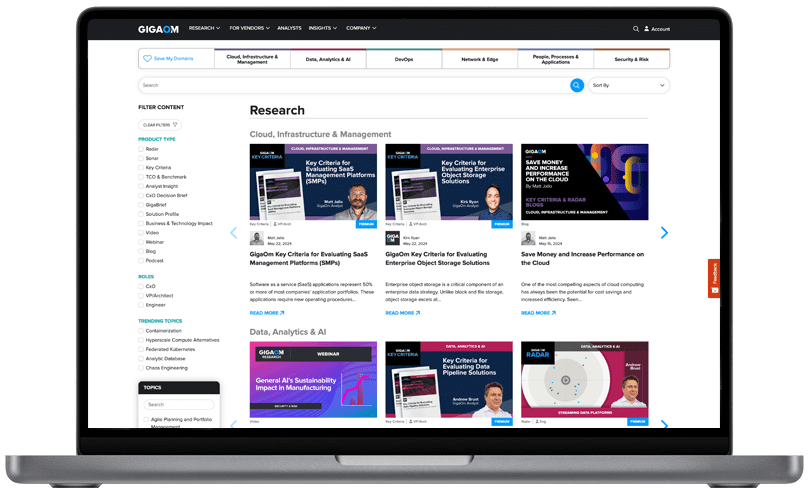Table of Contents
- Executive Summary
- Edge Development Platforms Sector Brief
- Decision Criteria Analysis
- Analyst’s Outlook
- Methodology
- About Andrew Green
- About GigaOm
- Copyright
1. Executive Summary
Edge development platforms operate globally distributed infrastructure and offer computing and developer services for creating and running applications closer to end users. They are built upon novel technology stacks that are optimized for near-instant processing of web requests, minimizing the latency associated with networking, compute, and storage. They do this by operating globally distributed points of presence (PoPs) located close to end users, running edge-native execution environments, and employing simple and fast storage architectures.
Edge development platforms are an evolution of content delivery networks (CDNs), which, though still relevant, have remained architecturally stagnant since the early 2000s. CDNs rely on global PoPs to cache web resources for quicker load times.
By far the most important asset of CDNs is their geographically distributed infrastructure. Upon this foundation, other providers of global infrastructure, such as cloud and telecommunications providers, have built content delivery applications, contributing to the evolution of the CDN market.
Edge computing brought a considerable shift in the market, which manifests itself in the following ways:
- CDNs employ edge compute for advanced web delivery use cases, such as real-time web page personalization.
- Multiple vendors have sold their CDN businesses to focus exclusively on edge compute services.
- Newer vendors are building edge development platforms from scratch, bypassing content delivery applications.
This iteration of the report attempts to capture the evolution of this space. Previously named Edge Platforms and focused on content delivery features and edge compute capabilities, this report has been updated as Edge Development Platforms, which now evaluates compute services and the developer experience rather than content delivery.
Most use cases addressed by these solutions involve services that are accessed by consumers through websites, typically in industries such as ecommerce, digital media, financial services, healthcare, and others. However, we expect an increase in some enterprise use cases, especially involving IoT, OT, or other field-related applications, far away from office locations.
Business Imperative
Considering that most use cases for edge development platforms are related to web-based resources, organizations will have already developed some delivery and optimization mechanisms. This means that deploying or migrating to an edge development platform will likely pose only incremental product evolutions. For example, an ecommerce organization will have most of the core functionality in place but could use an edge development platform to roll out features such as real-time offers or session-sensitive personalized product recommendations.
There may be some novel use cases that fully depend on low latency that can’t be achieved on cloud infrastructure, in which case the need to deploy an edge development platform will be considerably higher.
Sector Adoption Score
To help executives and decision-makers assess the potential impact and value of an edge development platform deployment to the business, this GigaOm Key Criteria report provides a structured assessment of the sector across five factors: benefit, maturity, urgency, impact, and effort. By scoring each factor based on how strongly it compels or deters adoption of an edge development platform, we provide an overall Sector Adoption Score (Figure 1) of 3.8 out of 5, with 5 indicating the strongest possible recommendation to adopt. This indicates that an edge development platform is a credible candidate for deployment and worthy of thoughtful consideration.
The factors contributing to the Sector Adoption Score for edge development platforms are explained in more detail in the Sector Brief section that follows.
Key Criteria for Evaluating Edge Development Platforms
Sector Adoption Score
Figure 1. Sector Adoption Score for Edge Development Platforms
This is the fourth year that GigaOm has reported on the edge development space in the context of our Key Criteria and Radar reports. This report builds on our previous analysis and considers how the market has evolved over the last year.
This GigaOm Key Criteria report highlights the capabilities (table stakes, key features, and emerging features) and nonfunctional requirements (business criteria) for selecting an effective edge development platform. The companion GigaOm Radar report identifies vendors and products that excel in those decision criteria. Together, these reports provide an overview of the market, identify leading edge development platforms, and help decision-makers evaluate these solutions so they can make a more informed investment decision.
GIGAOM KEY CRITERIA AND RADAR REPORTS
The GigaOm Key Criteria report provides a detailed decision framework for IT and executive leadership assessing enterprise technologies. Each report defines relevant functional and nonfunctional aspects of solutions in a sector. The Key Criteria report informs the GigaOm Radar report, which provides a forward-looking assessment of vendor solutions in the sector.
